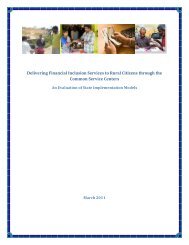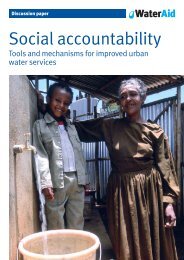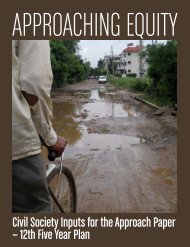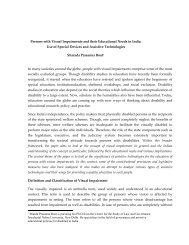Changing Framework of Local Governance and - Create
Changing Framework of Local Governance and - Create
Changing Framework of Local Governance and - Create
Create successful ePaper yourself
Turn your PDF publications into a flip-book with our unique Google optimized e-Paper software.
<strong>Changing</strong> <strong>Framework</strong> <strong>of</strong> <strong>Local</strong> <strong>Governance</strong> <strong>and</strong> Community Participation in Elementary EducationThis calls for a provision <strong>of</strong> planning distinctively for the urban areas either as separateplans or as part <strong>of</strong> District Plans in the case <strong>of</strong> smaller towns. In either case, this wouldrequire partnership with NGOs, Municipal bodies, etc. (GoAP, 2009).Many initiatives have been established by different state governments to bring the children <strong>of</strong>the urban poor into schools. However, this is not an easy task as these urban poor children areheterogeneous groups who require diversified approaches <strong>and</strong> strategies for their education.These might include flexible strategies like bridge courses, remedial teaching centres,residential camps, drop-in-centres <strong>and</strong> half-way homes. All strategies require extensivecommunity mobilisation <strong>and</strong> prior work at the local level with parents, children, NGOworkers, employers <strong>and</strong> other stakeholders working in local governing bodies (GoI, 1999).In addition to urban local bodies, the involvement <strong>of</strong> other agencies can also be important.These agencies include the L<strong>and</strong> Development Agency, Cantonment Boards <strong>and</strong> Railways,Police, Association <strong>of</strong> Contractors <strong>and</strong> their regulating authorities, Ministry <strong>of</strong> Women <strong>and</strong>Child Development, Ministry <strong>of</strong> Urban Development, Department <strong>of</strong> Transport <strong>and</strong> theJudiciary. For instance, in Ch<strong>and</strong>igarh:The Executive Committee <strong>of</strong> Sarva Shiksha Abhiyan, Union Territory (UT),Ch<strong>and</strong>igarh decided to involve the community <strong>and</strong> elected representatives <strong>of</strong>Panchayati Raj Institutions, local bodies, PTAs <strong>and</strong> other grass root level groups in themanagement <strong>of</strong> elementary education to improve accountability <strong>and</strong> transparency.Therefore, Education Committees, involving the members <strong>of</strong> the community, havebeen constituted at Cluster level with the Councillors <strong>of</strong> the respective wards <strong>and</strong>members <strong>of</strong> the Ward Committees <strong>and</strong> PTAs…… The Executive Committee hasdecided to enter into partnership with Non Government Organizations (NGOs) formainstreaming <strong>of</strong> out-<strong>of</strong>-school children <strong>and</strong> for capacity building <strong>of</strong> community. Ithas also decided to constitute another Committee in convergence with UT LabourDepartment to eliminate child labour <strong>and</strong> to bring these children to main stream <strong>of</strong>education……. It was proposed to open Day Care Centres near the labour colonies,villages <strong>and</strong> slums to relieve the elder children from the responsibilities <strong>of</strong> sibling care.These Day Care Centres should commensurate with the working hours <strong>of</strong> theparents…… The Committee seriously viewed the shortage <strong>of</strong> class rooms <strong>and</strong> learningspaces in various schools <strong>and</strong> for Alternative Innovative Education (AIE) centres <strong>and</strong>for non-fulfilment <strong>of</strong> the target fixed for construction <strong>of</strong> school buildings <strong>and</strong>additional classrooms in schools….. It was decided to allot construction work <strong>of</strong> schoolbuildings to Ch<strong>and</strong>igarh Housing Board to speed up the execution <strong>of</strong> the project forexpansion <strong>of</strong> the capacity. It was also decided that school education committees mayget prefabricated structures raised for additional classrooms as per their requirementsunder the guidance <strong>of</strong> Ch<strong>and</strong>igarh Housing Board (Government <strong>of</strong> Ch<strong>and</strong>igarh, 2008).From the above analysis it is clear that in recent years Indian states have been developing theiradministrative structures for implementing the PRI Act which has provided the framework fordecentralization. Ironically, the completion <strong>of</strong> the Act depends on the action taken by the state.It is because <strong>of</strong> this, the status <strong>of</strong> implementation <strong>of</strong> this Act varies across the states. Asmentioned above, in Madhya Pradesh, decentralization is confined to delegatingadministrative power <strong>and</strong> functions whereas in Kerala, PRIs are involved in planning,implementation <strong>and</strong> monitoring <strong>and</strong> 40% <strong>of</strong> the state budget was given to PRIs. Karnataka <strong>and</strong>West Bengal are in the process <strong>of</strong> strengthening their PRIs. Financial constraints have been amajor hindrance in many states including West Bengal in the implementation <strong>of</strong> the Act. The16

















